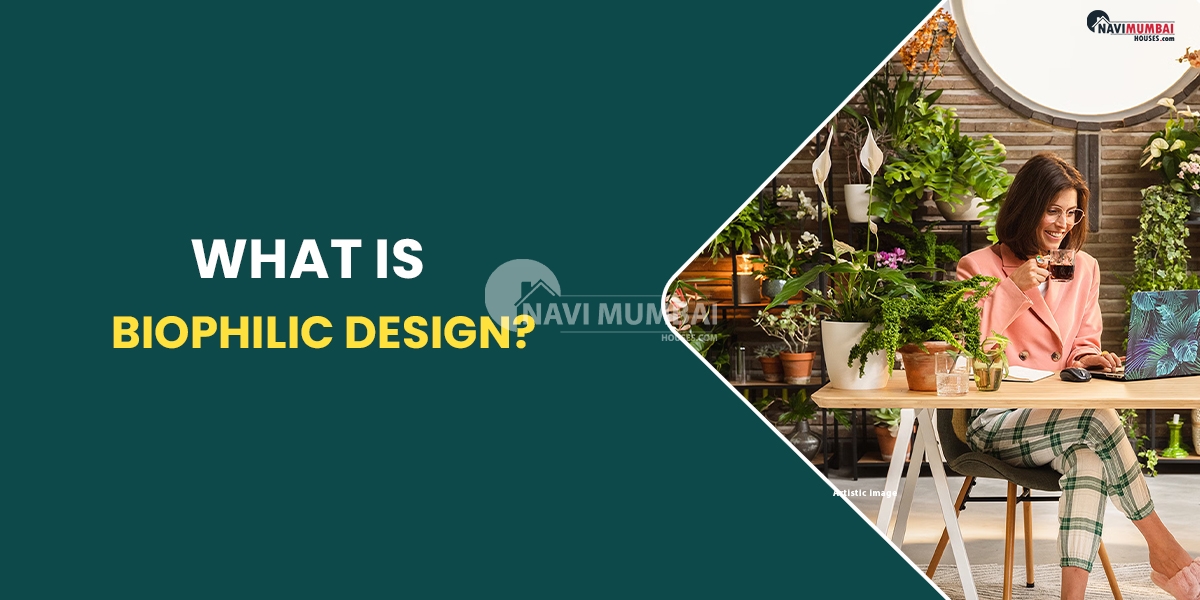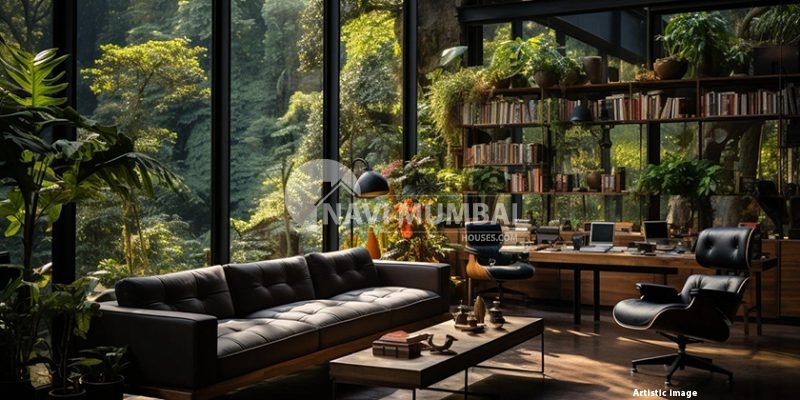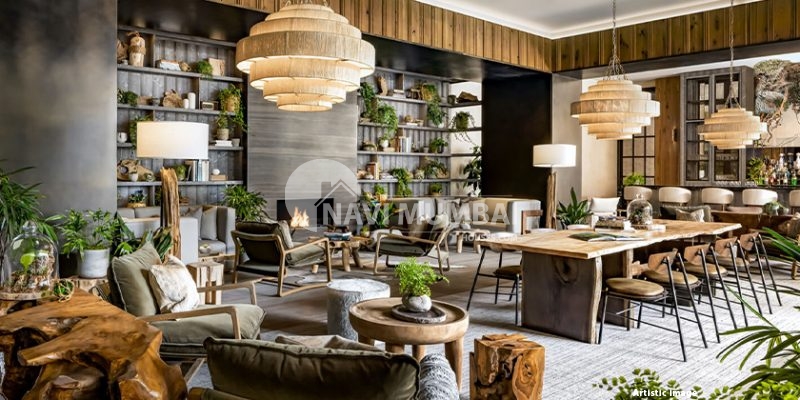
- April 19, 2024
- Decor, Life Style, News
What Is Biophilic Design?
Building occupants can benefit economically, environmentally, and healthily from biophilic design. The idea of “biophilic design” is applied in the building sector to improve occupant connectivity with the natural world. It entails integrating space and place conditions, direct and indirect nature, and nature into cities and buildings. The concept of biophilic design improves urban areas and building occupants in terms of health, the environment, and the economy.
Are you searching 2bhk flat for rent in Kamothe?
Biophilic architecture has been document throughout history; prominent examples include the Hanging Gardens of Babylon. Since psychotherapist Erich Fromm initially coined the term “biophilia,” scientists and philosophers such as Edward O. Wilson have developed and popularized it.
The biophilia hypothesis
According to Edward O. Wilson’s “biophilia hypothesis,” humans are inherently drawn to life and lifelike processes because of our evolutionary reliance on the natural world for both survival and fulfilment. This theory has application in daily life because people frequently seek out nature through excursions, hiking, and time spent in unspoiled areas. Given the prevalence of pet ownership, it is evident that humans love animal interaction as well. Studies demonstrating the beneficial impacts of nature exposure on overall contentment, mental health, and physical health have bolstered the biophilia concept. People are also ready to pay extra for residences with access to natural amenities and views of the outdoors, as evidenced by the real estate market.
Dimensions of biophilic design
The framework of biophilic design is define by multiple dimensions that are include. Direct experience of nature refers to the sense of being in physical contact with elements such as air, water, light, plants, animals, weather, and natural landscapes. Through this up-close encounter, people can fully immerse themselves in the sensory components of the natural world, strengthening their bond with it.
The indirect experience of nature is an additional dimension that encompasses interactions. With artwork, natural materials, natural colours, and artificial light and air simulations, among other pictures and representations of nature. People can feel a feeling of nature even in artificial environments thanks to this indirect experience, which strengthens people’s bond with the natural world.

Environmental features
Environmental elements are important to biophilic design. It is possible for designers to create places that replicate the natural environment by combining factors like sunshine, plants, water features, and natural materials. By giving users a firsthand experience of nature, these elements improve a space’s aesthetic appeal while also improving people’s general well-being.
Natural forms and shapes
The value of organic forms and shapes in fostering a sense of connection to the natural world is acknowledge by biophilic design. Designers may bring the sense of nature within by fusing biomorphic and botanical forms into furniture, architectural elements, and other items. The use of organic shapes and forms enhances people’s sense of being in the middle of nature.
Evolved human-nature relationships
The examination of evolutionary interactions between humans and nature is another facet of biophilic design. Our evolutionary connection to nature can be evoke by design components that foster prospect and sanctuary, curiosity and enticement, mastery and control. These components are use by designers to build environments that satisfy our innate desire for a connection to the natural world.
Natural patterns & processes
Biophilic design also takes into account the importance of natural processes and patterns. Design elements that are drawn from the natural world, such as sensory diversity. And information richness, can be use to provide a dynamic and captivating space. Using components like flowing water, fractal patterns, or changing seasons, designers can portray the complexity and rhythm of the natural world.
Place-based relationships
A focus of biophilic design is the relationship between environment and place. Spaces can provide a feeling of locality and forge closer ties to the natural world by combining geographic, historic, ecological, and cultural factors into the design. With the help of this place-based approach, people can form deep connections with their environment.
Space and light
Using space and light effectively is essential to biophilic design. A feeling of being outside can be evoke by filters and natural light. As well as the play of light and shadow. The impression of expansiveness connected with the natural world is also enhanced by the building of open and airy surroundings. Designers can improve the biophilic experience by paying close attention to how light and space interact.

Advantages of biophilic design
Numerous benefits for human health, wellbeing, and productivity come with biophilic design. We can improve physical and mental health, satisfaction, and pleasant connections by introducing natural aspects into our built settings.
Enhanced recovery and reduced health problems
It has been demonstrate that exposing people to environment through biophilic design speeds up their recuperation from illness or surgery. According to studies, having access to natural surroundings and vistas can lessen stress and encourage healing. Which speeds up recovery and enhances general wellbeing. Furthermore, biophilic design has been connect to a decrease in social and physical health issues, resulting in a longer, better life.
Improved performance & motivation
Productivity & motivation can be greatly increased in offices and learning environments by implementing biophilic design principles. It has been demonstrate that having access to natural factors like sunlight, grass, and open spaces enhances cognitive function, concentration, and creativity. These settings benefit from having nature because it lowers stress levels, which improves general well-being and job satisfaction.
Promotion of wellbeing and physical health
Biophilic design promotes outdoor activities and mobility, which both improve physical health. Communities and metropolitan areas that incorporate natural elements & landscaping encourage physical activity, which leads to a better way of life. Furthermore, studies have linked time spent in nature to lowered levels of stress hormones, blood pressure, and heart rate. All of which improve general health and quality of life.
Better mental well-being and satisfaction
Design that is biophilic has a big impact on happiness and mental health. Anxiety, sadness, and exhaustion can all be lessened by being in or among natural environments or environments with natural elements. It has been demonstrated that natural light, access to green areas, and views of the outdoors improve mood, promote relaxation, and raise life satisfaction overall. Furthermore, it has been demonstrated that biophilic design fosters wholesome social connections and a more robust feeling of community, which raises happiness & a sense of belonging.
Creating emotional attachments
The capacity of biophilic design to foster sentimental ties to locations and situations is one of its main advantages. People form a closer bond with their environment when they incorporate both direct & indirect experiences of nature, such as those found in natural materials, plants, water features, and artwork that depicts nature. Positive connections with the natural environment, a sense of ownership, and wellbeing are all promoted by these emotional attachments.
Using biophilic design in practice
Designers must take into account a variety of components and characteristics that characterize the biophilic design approach when putting it into practice. Establishing a relationship with nature requires incorporating different environmental factors. Sunlight, vegetation, animals, natural materials, vistas, and landscapes are a few examples of these attributes.
A further method to improve the biophilic experience is to incorporate natural forms and shapes into the design. Incorporating biomorphic designs and botanical elements can help achieve this.
Natural patterns and processes can be include into the design to give depth and intrigue in addition to these aesthetic components. To design a more engaging experience, think about leveraging information richness and sensory diversity.
Using space and light effectively is essential to biophilic design. Including elements like light and shadow, natural & filtered light, and space can enhance the biophilic experience as a whole.
Designers might concentrate on place-based relationships in order to create a strong sense of place. Geographical, historic, ecological, and cultural components can all be include into the design to accomplish this.
Lastly, highlighting the relationships between developed humans and nature can improve the biophilic design as a whole. A more significant and captivating atmosphere can be produced by incorporating elements like prospect and refuge, curiosity & enticement, and mastery and control.
These components can be effectively include into biophilic design projects in a variety of ways. Through examining many case studies and illustrations. Designers can acquire motivation and understanding on how to craft genuinely immersive and nature-focused environments.

Challenges & Obstacles in Biophilic Design Applications
A rising detachment from nature characterizes modern life, which presents a number of challenges and obstacles for biophilic design. Many constructed environments, such as workplaces, medical facilities, and educational institutions, have environmental deficits that result in situations devoid of sensory details. Essential natural features like sufficient light, ventilation, natural materials, greenery, and views are absent from these manufactured habitats. People who are in these areas consequently feel cut off from nature. Which can result in exhaustion, illness symptoms, and decreased productivity.
The absence of natural elements in these settings leads to an impoverished atmosphere that has an impact on people’s productivity and well-being. Nevertheless, overcoming these obstacles and improving productivity and health in these environments can be accomplish by implementing biophilic design components. A more organic and peaceful ambiance can be produce by adding natural lighting. Opening up vistas of the outside world, and including plants into these settings.
A change of perspective and an appreciation of the significance of our relationship with nature are necessary to overcome these obstacles. It entails putting into practice a new framework for architectural design that gives natural features priority. It is possible to lessen the negative impacts of being cut off from nature by giving priority to biophilic design concepts. Which result in environments that support human potential and well-being.
You’re looking for Projects in Belapur have the Best Properties In Navi Mumbai Like Ready to Move:https://navimumbaihouses.com/properties/search/belapur/
If you want daily property update details please follow us on Facebook Page / YouTube Channel / Twitter





